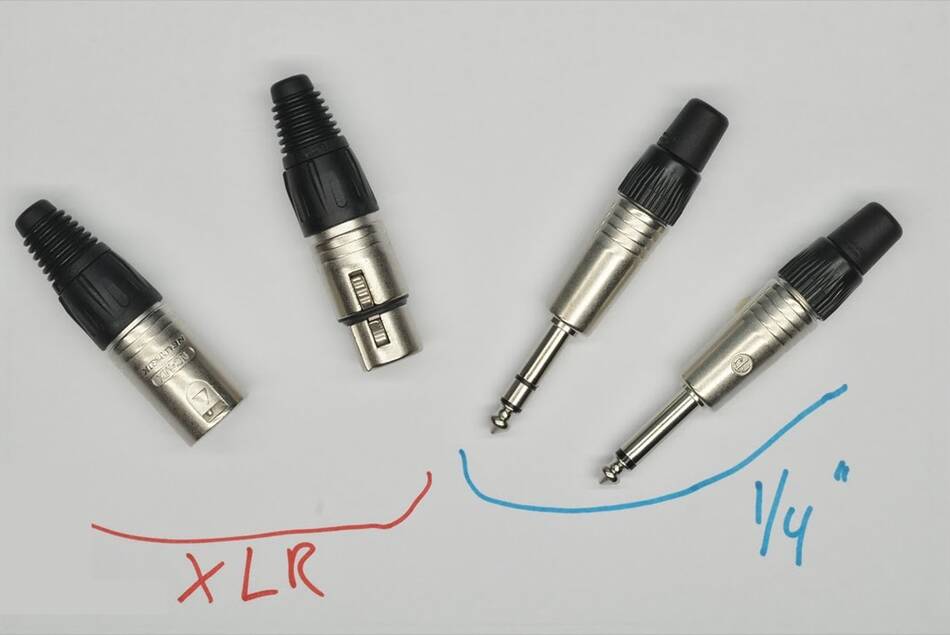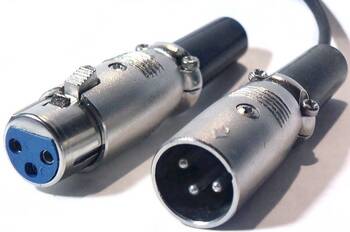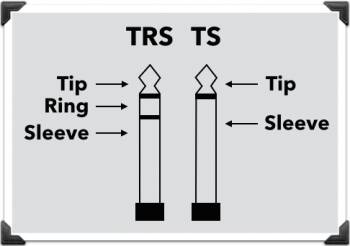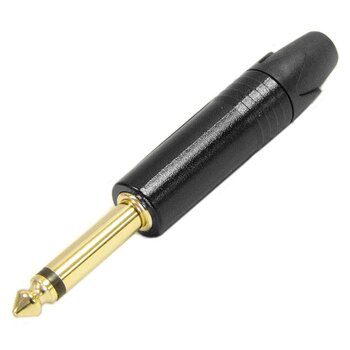
In the professional audio world, two of the most common audio ports and jacks you will find are the XLR and the 1/4 inch. For this reason, many types of audio equipment such as mixers, audio interfaces, keyboards, and guitars either include one or both of these ports on their devices.
This brings up the question for many beginners: which is the better choice — XLR or 1/4 inch?
There is no noticeable difference in sound quality between XLR and 1/4 inch TRS connectors and cables. They are both balanced and can deliver a stereo audio signal. However, XLR is a better option compared to 1/4 inch TS cables.
Let’s first examine XLR and 1/4″ jacks in detail, their differences, and advantages. And then we will follow that up with when to choose one over the other. Let’s dive into it.
Table of Contents
What is XLR?

The full form of XLR is External Line Return. According to Wikipedia, this is a connector made in the early ’90s by James H. Cannon, which is why you hear some people refer to XLR as Cannon connectors. But what exactly does an XLR do?
XLR connectors are designed to transfer electrical current from one device to another. They are popularly used in the audio space to transfer audio signals, which are essentially electrical current between devices. Mixing consoles, amplifiers, speakers, musical instruments, microphones, and other audio devices use XLR connectors to send and receive audio signals.
Some people also refer to XLR cables as microphone cables. That’s because, for many years, this was the standard connector used for microphones.
Although XLR is popularly known as an audio cable, it is not restricted to only audio. Some stage lighting engineers use XLR cables for their lighting gear. They are not common, but some people do it.
Inside an XLR cable are three wires — ground (X), Left or Hot (L), and Right or Cold (R). Both the Hot and Cold (or Left and Right) wires carry the actual electrical current, while the ground is pretty much the ground. This three-wire configuration makes an XLR cable a balanced cable. And I’ll talk more about that later in the article.
As you may already know, there are two main types of XLR connectors — Male and Female XLR connectors. Male XLR connectors have three pins inside the connector, and the Female XLR has three pinholes.
On most audio equipment, Male XLR connectors are used to send audio signals, while female XLR connectors receive audio signals. For instance, microphones have male XLR connectors that send signals from the microphone.
Similarly, the Aux Outputs on mixing consoles have Male XLR connectors for sending audio signals out of the mixer. However, mixer inputs have female XLR connectors for receiving audio. You get the point.
I think that’s enough on XLRs. Now let’s talk about 1/4″ connectors.
What is a 1/4 inch Connector?

1/4 inch (usually referred to as quarter-inch) connectors are used in both professional and consumer audio equipment. They are also one of the most used audio connectors out there. 1/4″ is used interchangeably with 6.35mm, simply because the millimeter equivalent of 1/4″ is 6.35mm.
So if you are out there shopping for 1/4″ connectors, adapters or cables, just know they are also referred to as 6.35mm connectors.
1/4″ connectors are used on mixing consoles, preamps, power amplifiers, receivers, DACs, audio interfaces, instruments such as guitars, keyboards, digital pianos, and synthesizers. However, many people know the 1/4″ connector as a headphone jack because it’s the standard connector for many headphone manufacturers.
Similar to XLR, there is a Female 1/4″ connector and a Male 1/4″ connector. The female 1/4″ connector is usually the one in your audio equipment, and then the male 1/4″ connector is plugged in it.
Also, it’s important to know that there are two types of 1/4″ connectors — TS and TRS. Now let’s take a look at both of them and what makes them different.
TS

TS is an abbreviation for Tip-Sleeve. As you can see from the image, there are two sections of this connector. The tip of the connector is referred to as the Tip (of course), and the black line on the second section is known as the Sleeve.
The Tip of a 1/4″ connector carries the actual audio signal, while the Sleeve is the ground. This means 1/4″ cables have two wires in them — the positive, which carries the audio signal, and the ground.
1/4″ TS cables are unbalanced cables. And I’ll explain what that means later in the article.
TRS

For those who don’t know, TRS is an abbreviation for Tip-Ring-Sleeve. The tip of the connector remains the Tip. And on the second section, there are two lines. The first line is the Ring, and the second line is the Sleeve.
There are three wires in TRS cables — ground, left or hot, and right or cold. The Tip and Ring carry the Hot and Cold signals (or Left and Right signals), and the Sleeve is the ground.
1/4 inch TRS cables are balanced cables.
XLR vs 1/4 Inch Connectors
Now that we have established that there are two kinds of 1/4 inch connectors let’s compare them to the XLR
| XLR | 1/4″ TS | 1/4″ TRS | |
| Balanced | Yes | No | Yes |
| Stereo | Yes | No | Yes |
XLR vs 1/4 inch TS Connectors:
As I mentioned earlier, XLR cables are balanced cables, while 1/4 inch TS cables are unbalanced cables. This is the big difference between the two.
The downside of unbalanced cables such as the 1/4 inch TS cables is that they can pick up noise and signal from radios and antennas nearby. When you use a TS cable about 15 to 20 feet long, you’ll definitely notice a significant unwanted noise in your audio signal.
This can drastically reduce the audio signal’s sound quality and sometimes make it undesirable. This is the biggest downside of 1/4 inch.
Also, 1/4 inch TS cables can only mono signals. It has only one wire which is able to deliver only one signal. The other wire is just ground. This is why 1/4 inch cables are usually used with guitars because it’s a mono instrument. Now let’s talk about XLR.
XLR cables and connectors are balanced. This means you can run these cables as long as you want, and there will be no noise at all in the audio signal. They do pick up noise, but when it gets to the other end of the cable, the noise gets filtered out, leaving the clean audio signal.
Also, XLR cables can deliver stereo signals. It has two wires that carry the left and right channels of a stereo signal.
XLR vs 1/4 inch TRS Connector
There is no noticeable difference between an XLR and 1/4 inch TRS connectors or cables in terms of sound quality. They are both balanced cables, meaning there will be no noise in your audio signal.
Also, both XLR and TRS cables can carry stereo signals. They both have two wires to carry the left and right channels of a stereo signal. So the only difference between an XLR and a 1/4 inch TRS is the actual connectors. Both can deliver high-quality noise-free stereo audio signals.
Reasons to Choose XLR over 1/4 inch.
There are situations where it simply makes sense to go for an XLR over 1/4 inch connector. Here are a few reasons why
1. Ability to send phantom power
Condenser microphones require phantom power, usually 48V, to work. This is usually delivered to the mic through the audio cable. The best audio cable which can deliver power to a condenser microphone
So, if you want an audio cable for your condenser mic, it’s a no-brainer to go for an XLR cable.
2. Best cable for microphones
As I mentioned earlier, XLR cables have been the standard cable for microphones for decades, and they still are. Let me explain.
For a long time, XLR has been viewed as microphone cables. Microphones deliver a much quieter audio signal known as mic-level signals. For this reason, microphone signals usually have to be boosted by a preamp before it can be loud enough for further processing.
Professional Audio equipment manufacturers know this as well. So audio equipment such as audio interfaces or mixing consoles have a preamp built into their XLR connectors. This means you’ll only have access to the microphone preamps, which will boost your mic’s signal if you use an XLR cable for your mic.
3. Locking mechanism on XLR
Another great thing about XLR connectors is their locking mechanism. This is usually common with Female XLR connectors.
The locking mechanism on XLR connectors prevents accidental cable pull-outs, which may happen when someone trips on a cable. This is a problem in the live production, which was easily solved with the locking mechanism on XLR cables.
So if you want to prevent accidental cable pull-outs, which usually happens with 1/4 inch connectors, you should definitely go for XLR connectors.
4. Daisy-Chain Multiple XLR cables
Another handy feature about XLR cables is that when you need a longer cable; you can daisy-chain multiple short cables to form one long cable. This simply means you’ll plug the male XLR connector of one cable to the female XLR connector of the next cable, and so on, till you get one long cable.
This cannot be achieved with 1/4 inch cables since both ends of 1/4 inch cables are male connectors. This is just something you need to keep in mind when you go audio cable shopping.
Reasons to Choose 1/4 inch over XLR
Here are situations where it’s best to go for 1/4 inch over XLR
1. They are cheaper
1/4 inch cables are much cheaper than XLR. So if you want to save some cash, it’s a good idea to go for a 1/4 inch cable, preferably TRS. You’ll still get the same sound quality of an XLR cable at a lower price.
2. Standard cable choice for instruments
1/4 inch connectors are the standard connectors for musical instruments like guitars, bass, keyboards, digital pianos, and synthesizers.
Recently, newer keyboard workstations are including XLR connectors, but for many instruments out there, the only option you’ll have is a 1/4 inch connector. So that’s something to keep in mind.
3. Great choice for patch cables
You should definitely go with 1/4 inch cables for your guitar effect pedal patch cables. Even 1/4 inch TS cables will work great. That’s because patch cables are short, so there will be no noise interference in your signal. Also, 1/4 inch TS cables are much cheaper than TRS.
Conclusion
In summary, both XLR and 1/4″ TRS can deliver stereo signals and are balanced cables. This means there won’t be any noise in the audio signal. 1/4″ TS, however, can only deliver mono signal and can pick up noise, which can reduce your audio signal’s sound quality. This makes XLR connectors and cables a better option than 1/4″ TS connectors and cables.

Hi, I’m Raymond. A keyboard player, music producer, and writer. And I’m also the founder of this blog. As someone who has been working with several audio and music equipment and different musicians for many years, my goal is to answer all your questions on music and equipment, as well as the latest music software and technology. For more info, check out my about me page
